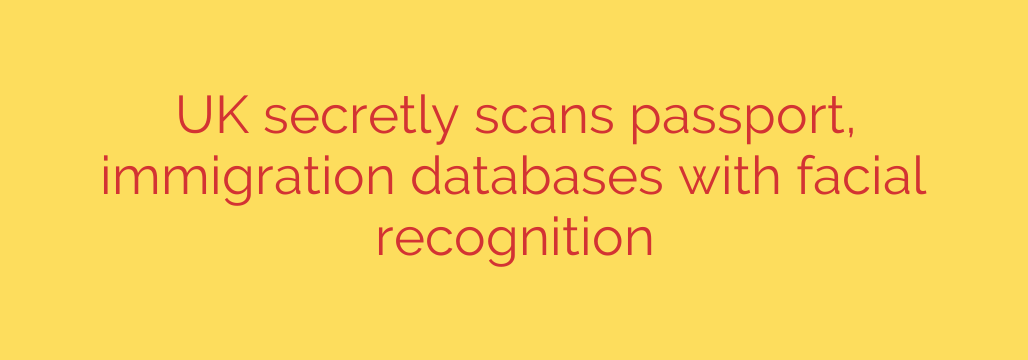
Your Passport Photo Could Be in a Police Lineup: Uncovering the UK’s Secret Facial Recognition Program
You probably remember the last time you renewed your passport. You took a clear, forward-facing photo, ensuring it met the strict government guidelines. You likely assumed that this image would be used for one purpose only: to verify your identity at border control.
However, you might be surprised to learn that your passport photo, along with millions of others, may have been incorporated into a vast, searchable facial recognition database used by UK law enforcement. This is happening quietly, without public debate or explicit consent, raising significant questions about privacy, security, and the expansion of state surveillance.
What Exactly Is Happening?
The UK Home Office is operating a powerful facial recognition system that taps into two enormous databases of citizen and migrant photos. This technology allows police to take an image of an unknown person—perhaps from CCTV footage or a witness’s phone—and scan it against millions of official records to search for a match.
The two primary databases being used are:
- The HM Passport Office database: This contains the passport photos of tens of millions of British citizens. These images were provided under the assumption they would be used solely for travel and identification purposes.
- The Immigration and Asylum Biometric System (IABS): This database holds the photographs and biometric data of millions of individuals who have applied for UK visas or sought asylum.
By combining these datasets, law enforcement has created a de facto digital lineup of a significant portion of the UK population, which can be scanned at will to identify individuals of interest in criminal investigations.
The Alarming Implications for Your Privacy
While the stated goal is to catch serious criminals and enforce immigration laws, this practice carries profound risks and sets a worrying precedent.
- Function Creep and Lack of Consent: Your passport photo was not provided to be part of a perpetual police lineup. Using it for criminal investigations represents a classic case of “function creep,” where data collected for one purpose is later used for another, far more intrusive one. This has been implemented without public consultation or an act of Parliament.
- The Danger of Inaccuracy: Facial recognition technology is not perfect. Studies have repeatedly shown that these systems can have higher error rates for women and ethnic minorities, increasing the risk of false positives. A mistaken identity could lead to wrongful investigation, arrest, and devastating consequences for an innocent person.
- A Chilling Effect on Civil Liberties: The knowledge that the government is scanning millions of faces creates a surveillance infrastructure that can feel oppressive. It normalizes the idea that any citizen can be subject to a biometric search at any time. Privacy advocates argue this is a significant step towards a society where individuals are constantly tracked and monitored.
The Balance Between Security and Freedom
The government’s position is that these tools are essential for modern policing, helping to protect the public from serious harm and maintain secure borders. They argue that the searches are targeted and necessary for national security.
However, critics contend that the secrecy surrounding the program is deeply undemocratic. Such a significant expansion of state surveillance power should be subject to intense public scrutiny and robust legal safeguards, not quietly rolled out in the background. The lack of transparency prevents any meaningful debate about where the line between security and personal freedom should be drawn.
Actionable Steps and Security Tips for Citizens
While you cannot simply “opt out” of a government database, you can take steps to become more aware and advocate for better privacy protections.
- Stay Informed: Understand how biometric technologies are being used. Follow the work of privacy-focused organizations like the Open Rights Group and Big Brother Watch to stay updated on new developments.
- Contact Your MP: Your Member of Parliament is your representative. You have the right to write to them, express your concerns about the use of facial recognition on passport data, and ask what they are doing to ensure there is proper oversight and legislation.
- Practice Digital Hygiene: While this won’t stop this specific government program, it’s a good habit. Be mindful of where you share your image and personal data online. Understand the privacy policies of the apps and websites you use.
The quiet integration of facial recognition into our core national databases is a pivotal moment. It forces us to confront a critical question: What kind of society do we want to live in? One where our identity is protected, or one where our face is just another data point in a vast government search engine? The answer will define the future of privacy and freedom in the UK.
Source: https://go.theregister.com/feed/www.theregister.com/2025/08/08/uk_secretly_allows_facial_recognition/








